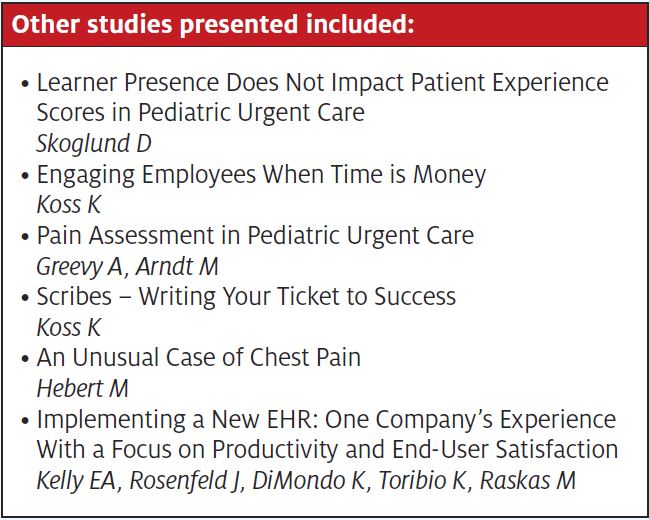Spotlight on Original Research in Pediatric Urgent Care: Excerpts from the 2020 Pediatric Urgent Care Conference (PUCC). Los Angeles, CA
David J. Mathison, MD, MBA
Decreasing Length of Stay in the Pediatric Urgent Care with Electronic Discharge Instructions*
Wooster J, Patel A, Nedved A, Lee B
The aim of this research was to determine if an electronic discharge process could decrease length of stay by an average of 10 minutes per patient. An electronic discharge procedure was implemented through a patient porta at a single freestanding pediatric urgent care, eliminating the use of hard copy instructions. After implementation, a retrospective manual audit was performed for patients on the 14th and 28th day of each month from August 2018 to April 2019 and stratified length of stay (LOS) (total and bedded) by means of discharge. The mean total LOS was calculated each month for the depart process type and trends were smoothed by using a 3-month moving average. The LOS measures were compared to patient satisfaction scores from the Patient Experience Survey (NRC) between the months of July 2017 and April 2019. Electronic discharge instructions decreased median LOS from 69 to 57 minutes for patients using the portal. The median LOS for patients receiving hard copy instructions was 66 minutes. The patient experience score increased from 72.3 to 78.4 with use of electronic instructions and a faster discharge. E-depart significantly decreases LOS and is associated with improved patient experience scores.
*Selected as Best Poster Presentation
Text Messaging as a Delivery Mode for Pediatric Urgent Care Patient Experience SurveysMontalbano A, Taff K
Montalbano A, Taff K
The primary objective was to improve patient experience survey response rates by utilizing text messaging as a delivery mode. Since parents in the Millennial age group have been the primary respondents to urgent care surveys, the authors hypothesized that text messaging may result in greater survey response rates than have been seen on inpatient units. Three hospital-affiliated pediatric urgent care sites with over 90,000 patient encounters a year introduced texting as a survey delivery mode for 6 months starting July 1, 2019. Compared with the same time period in 2018, the overall response rate decreased in 2019 by 2.8% (p=0.003); however, the drop-off rate decreased 11.4% (p<0.001) and responses with qualitative comments increased by 9.7% (p=0.024). While the introduction of text messaging as a mode for survey delivery did not significantly increase overall response rates in pediatric urgent care, participants that did respond were significantly more likely to complete the survey and provide more comments. Our study found that different modes of survey delivery may achieve different goals of generating patient experience feedback.
Pediatric Urgent Care: Educational Needs of a Growing Field
Pattishall A, Weinberg E, Coco T, Figueroa J, McCracken C, DiStefano M, Jackson C
This study aimed to foster better understanding of how well pediatric urgent care (PUC) training programs prepare trainees to practice PUC, and how PUC providers subsequently obtain CME. One hundred sixty-three physicians completed a needs assessment survey. Those who reported spending more than 25% of their clinical time practicing PUC were included in the analysis.
Non─fellowship-trained PUC physicians reported less preparation during residency for procedures such as fracture and joint reductions, regional and digital nerve blocks, and procedural sedation. They also felt less prepared to handle cases in areas such as dental emergencies and trauma. Pediatric emergency medicine-fellowship trained physicians reported less preparation for fracture reductions and regional nerve blocks. While PUC physicians obtain CME through a variety of methods, less than 20% categorized the CME they were obtaining as “PUC-focused.” Few physicians were “very satisfied” with their ability to obtain CME specific to PUC. These findings highlight gaps in training and educational opportunities for this growing group of practicing pediatricians.
Fever without a source in unvaccinated children 3 to 36 months – what workup is recommended?
Finkel L, Jimenez CO, Byers M, Eilberg W
The purpose of this review was to examine the current medical literature for recommendations pertaining to the evaluation of febrile unvaccinated children 3 months to 36 months of age without a clear source of infection. While the widespread use of childhood vaccines for H influenza type B (HIB) and Streptococcus pneumoniae (PCV7/13) has resulted in a decrease of occult bacteremia (OB) and serious bacterial infection (SBI) in these vaccinated children, there is not a standard of care for the evaluation and management in unvaccinated children who still benefit from herd immunity.
The authors found no studies specifically examining the rates of OB and SBI in unvaccinated children. Furthermore, no publications were found that provided recommendations for the evaluation of febrile unvaccinated children. At present, the rates of OB/SBI in febrile, well-appearing, unvaccinated children remains unknown. Further studies are needed to better understand the risk for OB/SBI in unvaccinated children in the post-pneumococcal vaccine era.

For information about next year’s conference, visit http://pucconference.com.

